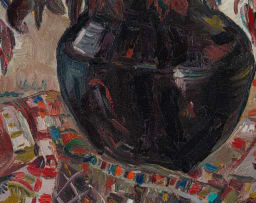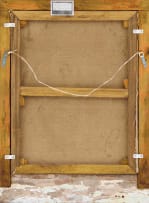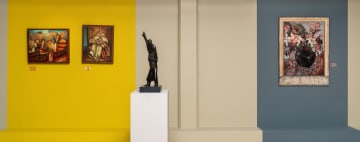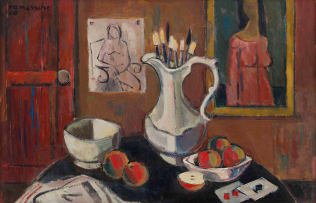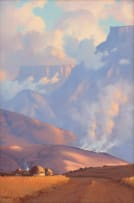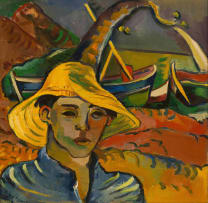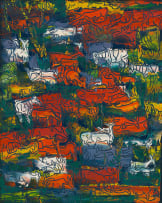Still Life with Lilies
Irma Stern
Incl. Buyer's Premium & VAT
About this Item
signed and dated 1948
Notes
Irma Stern realised quite early on in her career that the genre of still life offers many very distinct and very different expressive possibilities to an artist that figure studies or portraiture do not. An article in The Star newspaper reported that 'it was at her 1930 exhibition in Paris while hanging her pictures that [the artist] had difficulty in giving a total impression of her work without repeating her colour schemes. Brown, orange, red and green, were domineering colours in her canvases, and this made her think that her palette was limited except for a few still lifes in which she saw a wealth of colour, and on those still lifes she determined to build up her work'.1 The present lot is undoubtedly testimony of the success she achieved in and through her still life paintings. This genre not only provided an opportunity for formal experimentation, it also acted as a visual metaphor for the abundance and fecundity of nature, but also the transience of life. The vessel and the cloth on which it stands are permanent, and yet the flowers, the obvious transient element in the work, dominate the picture plane in this magnificent work.
After buying her house, The Firs, in Chapel Road, Rosebank, in Cape Town in 1927, Stern took to gardening. She listed the flowers being cultivated in her garden in a letter to her good friend Trude Bosse: '… larkspur, stocks, enormous geraniums, all shades of pelargoniums, great balls of white and also yellow daisies, violet and yellow poppies, sunflowers, and many, many roses, carnations, petunias, fuchsias.'2 Christopher Peter, director of the Irma Stern Museum for over 40 years, adds zinnias and delphiniums to the list.3 Although not mentioned in these lists, the indigenous amaryllis flower (common Afrikaans names seeroogblom, or gifbolblom) depicted in the present lot, was popularly planted as a cut flowers in local gardens in the 1940s and 50s, and it is likely that Stern also tried her hand at growing them. Debunking the myth that Stern only painted flowers from her own garden, Peter points out that her garden was 'cold, shady and tricky', maintaining that she in all likelihood bought showy flowers such as dahlias and chrysanthemums from the flower sellers along Adderley Street in the city centre. Given that these flower sellers routinely offer the arum lilies that grow wild along the many streams and ponds in the Western Cape, and that the amaryllis also grows wild in similar conditions, it is likely that Stern could have bought bunches of these amaryllis in the city as well.
The vase containing the flowers is a late-19th century Chinese storage jar, a martaban - with rotund body and heavy blackishbrown glaze - one of 10 martabani in Stern's vast collection of artefacts that was well-documented in an extensive inventory of her holdings when her house became a museum in 1971.4 Stern collected these artifacts and cultural objects locally and on her travels all over the world: from the barber shops on Long Street, Cape Town, where passing sailors often traded, barbered or exchanged exotic wares, to the Caledonian Market in Islington, London, in 1937, where she ran into South African artist, Edward Wolfe.5 It is possible that Stern bought the martabani on one of her visits to the island of Zanzibar in 1939 and in 1945. Describing the bazaar in Stone Town in her travelogue, Zanzibar (1948) she mentions not only the fresh produce and fresh fish, but also the abundant spices, ivory, gold and silver traded there, as well as textiles and ceramics. Her martabani are, in all likelihood, examples of lamu-pottery, Chinese ware made specially for the Arab Market.6 At the time of her visits, Zanzibar flourished as the confluence of trade routes from the Far East, the Middle East and from across Africa.
The cloth on which the martaban is placed significantly echoes the patterning and colours of the flowers, conjoining all in a celebration of tone and texture. From an examination of the inventory of textiles in the Irma Stern Museum, with examples from the Americas, Africa and the Middle and Far East, it seems likely that this particular example was a Javanese cloth from Indonesia, judging from the geometric designs of squares and star shapes.
Stern had infinite possibilities of combinations of containers and cloths in her collection, and different flowers either grown in her garden or bought on the street, at her disposal for use in still life compositions. Not only did the still life genre offer Stern the opportunity of experimenting with colour and composition, but it also allowed her to celebrate the infinite variety of life.
1. Anonymous (1931) The Star, 6 June, clipping in one of Irma Stern's scrap books (1914-1946) in the South African Library in Cape Town, as quoted in Karel Schoeman (1994) Irma Stern; The Early Years, 1894-1933. Cape Town: South African Library, page 99. This view is shared in a recent publication by Sean O'Toole (2020) Irma Stern: African in Europe, European in Africa. Munich: Prestel, page 94.
2. Irma Stern (1928) Letter to Trude Bosse, dated 14.11.1928, as quoted in Schoeman, ibid, page 88.
3. Wilhelm van Rensburg (ed.) (2018) Life Force: The Still Lifes of Irma Stern, Johannesburg: Strauss & Co, page 25.
4. Donald Inskip (ed.) (1971) Irma Stern Museum: Catalogue of the Collections in the Irma Stern Museum, Cape Town: University of Cape Town, pages 38 and 39.
5. Sandra Klopper (2017) Irma Stern: 'Are you still alive?' - Stern's life and art seen through her letters to Richard and Freda Feldman, 1934-1966, Cape Town: Orisha, page 69.
6. Ibid, page 86.
Provenance
The Jack Lewsen Collection.
Stephan Welz & Co, 31 May 2004, lot 518.
Graham's Fine Art Gallery, 2007.
Literature
Stephan Welz & Co, 31 May 2004, illustrated in colour on the front cover of the auction catalogue.
Wilhelm van Rensburg (2007) The Birth of the Modernist Body, Johannesburg: Graham's Fine Art Gallery, illustrated in colour on page 67 and incorrectly titled Lilies in an African Pot.




